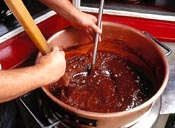FUDGE
Fudge is an interesting candy because if you do not pay close enough attention to the science behind it, it will not turn out right at all. The trick to making a smooth fudge starts at the beginning.
Making sure that you have a good pot to cook it in is essential. Copper kettles are most commonly used in the fudge making business due to their heating properties. Copper is a good thermal conductor and heats up evenly which is very important as to prevent burning. It could also affect the temperature the fudge is cooked to if the thermometer is resting on a "hot spot".
At about 220 degrees Fahrenheit (5/9*(220 + 40) - 40 ~ 104 degrees celcius), after consistently heating, the temperature will stop rising for a good deal of time. This is because the sugar in the fudge is going through a phase change (a phase change is when something changes from one state to another without a change in its chemical composition. ie: water changing to ice or steam). During a phase change, energy is going into the process without a change in temperature. In the case of fudge, the sugar is crystallizing which is a vital part of the process because it would not set up correctly otherwise. The final temperature of the fudge will be near 130 degrees Fahrenheit which actually varies with humidity! Days with more humidity the fudge will actually need to be cooked to lower temperatures than on hot days (if the humidity changes significantly, what would be a perfectly good temperature the day before might result in a rock hard fudge or a gooey pile of sugar). This is because less water from the fudge will be evaporated so if the temperature is raised the fudge will turn out hard.

http://www.alaskanfudge.com/
Next is cooking the fudge and beating it which allows the fudge to form microcrystals and set. If the fudge is beaten prematurely, too many crystals will form and the result will be an unattractive, rough looking loaf of fudge. This can also happen if only table sugar is used in the recipe. If different types of sugars are used such as corn syrup and invert sugar, they will interfere with eachother's crystallization processes and reduce the chance of crystallzing prematurely. If nuts are added to the fudge the cooking temperature of the fudge will actually have to be lowered slightly as the nuts will absorb some of the water from it.
FUN FACT: Chocolate, the main component of fudge, was first mass produced in 1770 with James Watt's improvements to the steam engine that mechanized the cocoa bean grinding process.